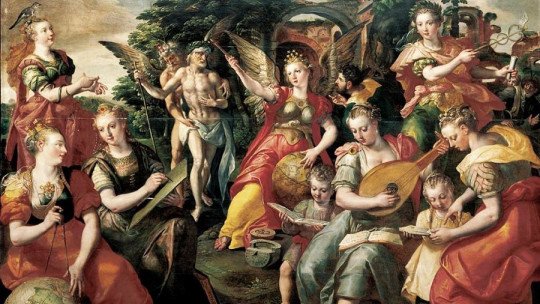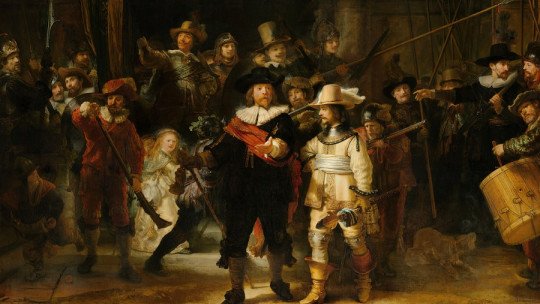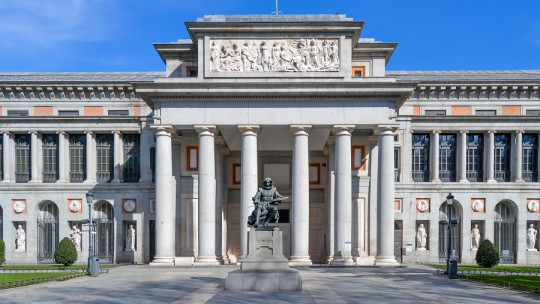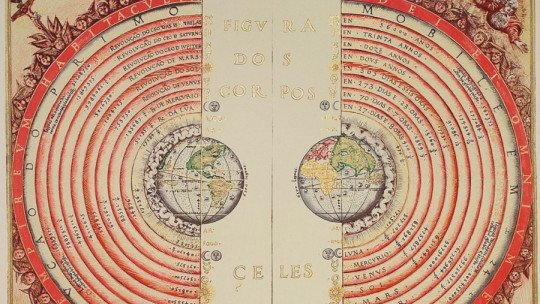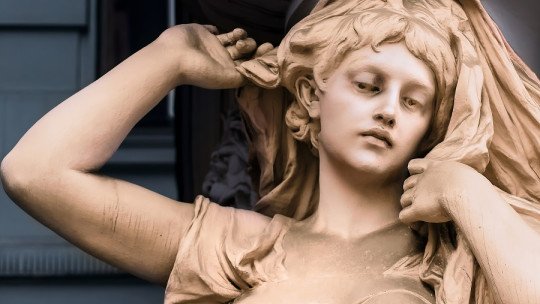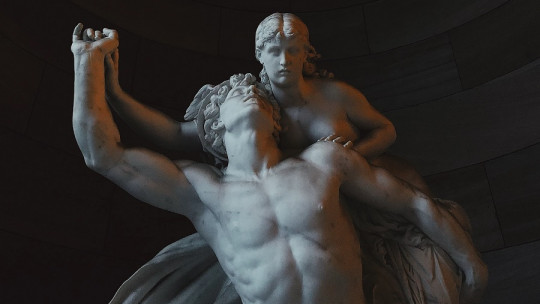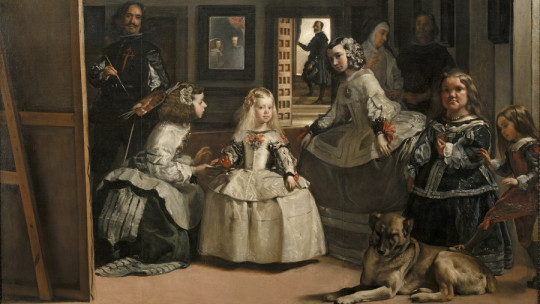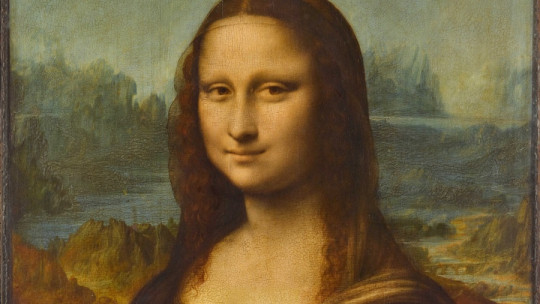In the Prado Museum in Madrid we find a beautiful chest front that shows the liberal arts The studies are personified by maidens who carry attributes and are accompanied by great masters of each discipline. In the center of the composition, eminently quattrocentist, we find Astronomy sitting on a throne, carrying the celestial sphere. At her feet stands Ptolemy, reading his work, in which he compiled a compendium of Greek astronomy.
To the left of Astronomy a splendid procession unfolds, the arts of Quadrivium: Geometry carries a square and a compass and leads Euclid by the hand; Arithmetic, a table to calculate and is accompanied by Pythagoras. Closing the group, Música plays an organ while Tubalcaín, the inventor of the instrument according to the Bible, watches her.
To the right of Astronomy we find another group. On this occasion, it is the Trivium: Rhetoric holds a long scroll of written paper, closely followed by Cicero; Next to her, Dialectica goes hand in hand with Aristotle and carries an olive branch (symbol of concord) and a scorpion, representing the opposite. Finally, Grammar, the first of her studies, is accompanied by two children and holds several books on her mantle. Behind her, a character, who may be Donato or Prisciano, closes her entourage.
What are the liberal arts?
The work of El Prado, executed in 1435 by the Florentine Giovanni dal Ponte (1376-1437), magnificently captures the concept of medieval liberal arts, which were still in force in the Renaissance and which, in fact, would not see their decline until the 20th century. XVIII, the era of Enlightenment.
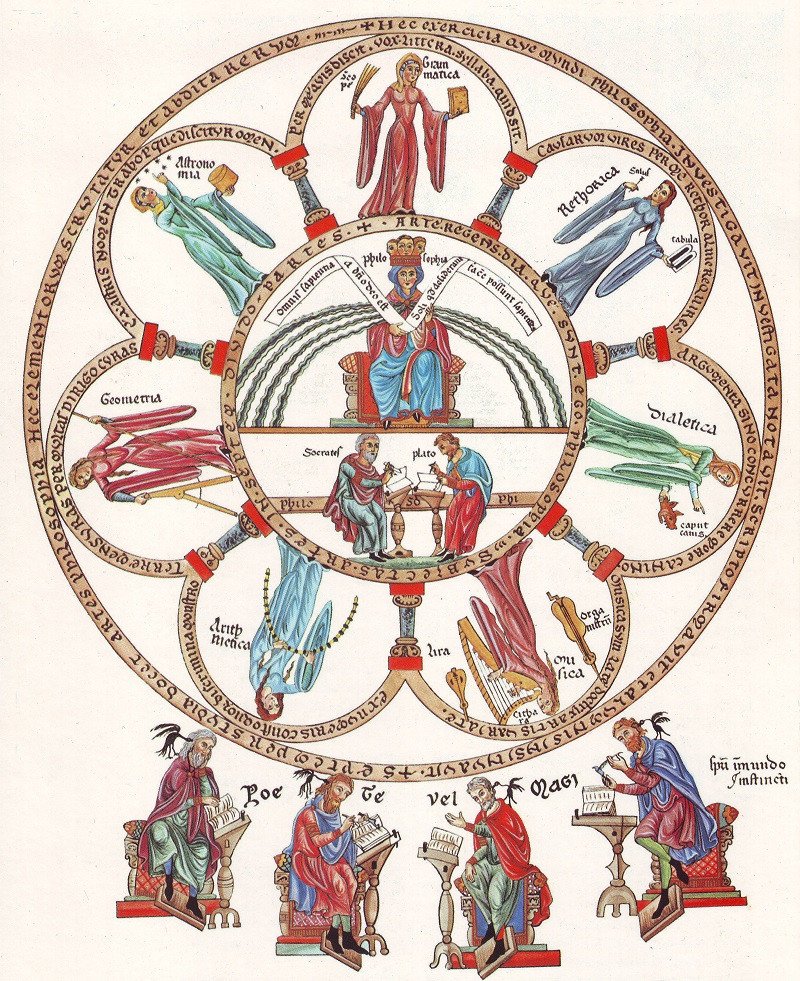
But what are the liberal arts? In this article we are going to detail what they consist of and how they differ from the so-called vulgar or manual arts. Let’s see it.
Arts only for free men
Although the fame of the liberal arts is due, especially, to the centuries of the Middle Ages (when they flourished through Scholasticism) The teaching of these arts dates back to classical times The term liberal art comes from bastfree in Latin, in a clear reference to those who exercise them, who are none other than free men, that is, those who are neither servants nor slaves.
Thus, the liberal arts are studies intended for the privileged classes of society. Its objective, unlike the vulgar arts or manuals, it was not economic, but, plain and simple, knowledge. Thus, while the servile arts were practiced by serfs and artisans, who did them to earn a living, the liberal arts had the exclusive goal of achieving wisdom.
This is entirely logical if we keep in mind that free men who studied this type of arts did not need to work to earn their bread. Let us remember that we are talking about members of the clergy and the aristocracy, so their sustenance was guaranteed through the income and various privileges they had. The only intention when pursuing liberal studies was a perfecting of the soul, an approach to God through reason, logic and knowledge.
A free man of the Middle Ages could not stoop to working with his hands The idea that social hierarchy was a classification established by God was very present; At the top of the pyramid were the orators (those who pray), personified by the ecclesiastical establishment; Secondly, came the bellatores (those who fight) and, finally, those laboratories (those who work), who supported the other two classes with their work.
Several things can be deduced from this scheme. First, the strict stratification of the feudal regime, which offered no possibility of changing social location, since permeability was zero. And secondly, at first, the members of the second estate, the bellatoresnor did they have access to the liberal arts, in that their profession (mainly war) was also considered a servile art.
Therefore, originally, the individuals who enjoyed liberal education were the members of the Church. Little by little, the privilege was extended to the nobility, but the members of the third estate (the laboratories) remained excluded and their access to the liberal arts remained highly restricted until the Enlightenment.
He Trivium and the Quadrivium
On the front of the chest of El Prado we have seen what liberal arts were that were consolidated in the Middle Ages. Specifically, it was Alcuin of York (d. 804) who established them in the 8th century, with the intention of establishing the educational curriculum that would direct the teachings of the Palatine School of Aachen, the capital of the Carolingian empire.
However, long before Alcuin there were thinkers who spoke of the importance of the liberal arts as a gateway to knowledge. Marcianus Capella (360-428) wrote in the 5th century his famous Satyriconin which he codified the seven liberal arts and he put into the mouths of each of them what their respective teachings were. A little later, during the reign of the Ostrogoth Theodoric (6th century), Magnus Aurelius Cassiodorus (d. 585) imbued the ancient classical liberal arts with an evident Christianity.
Thus, the seven liberal arts were established, considered the basic studies necessary to access higher education. In turn, these liberal arts were divided into two groups: the Trivium (in Latin, three ways), which compiled the arts related to language, and the Quadrivium (four ways), in which the disciplines related to the sciences.
This classification between letters and sciences is not, however, completely exact, since within the Quadrivium Music was also included, which in our current world is considered an artistic discipline. It is necessary to remember that, in the Middle Ages, as well as in the classical world and the Renaissance, there was no border between letters and sciences, and although it is true that everything related to mathematics was considered superior knowledge, the definitive classification did not arrive until the Enlightenment Classification, by the way, that continues to be maintained today.
What, then, make up the Trivium and the Quadrivium? In the first, grammar was studied (basic studies), logic or dialectics (which teaches how to use thought correctly) and rhetoric (the final phase of the Triviumin which linguistic skills are applied to argue and persuade).
On the other hand, the Quadrivium It was a higher step in access to knowledge, which was reached after having passed the Trivium. It was made up of arithmetic (calculus), geometry, music and, finally, astronomy, the most excellent of the liberal arts. Once the Quadrivium was completed, the student was considered prepared for specific studies, usually taught in medieval universities and which were usually Law, Medicine and Theology. The latter was considered the highest study, the ultimate goal of any aspirant to knowledge.
Liberal arts versus mechanical arts
The fact that the liberal arts focused on seven has a lot to do with the religious symbology of this number: seven were the gifts of the Holy Spirit, the sacraments and the Christian virtues, among many other concepts.
Probably because of the great popularity of seven as a highly symbolic number, in the 12th century The theologian Radulfo de Campo Lungo (1155-1215) tried to establish the mechanical or manual arts also in seven disciplines Among them, Radulfo included the art of war, navigation, agriculture and, surprisingly, medicine, which was considered a manual art until the appearance of university studies related to the subject. In this sense, the University of Montpellier, founded in the 12th century, stood out especially. Such illustrious figures as Arnau de Vilanova (d. 1311 or 1313) or Nostradamus (1503-1566) studied medicine there.
This last character serves to illustrate how the division between liberal and manual arts was still very present in modern times and did not definitively disappear until the 18th century. We have mentioned that Nostradamus studied medicine in Montpellier, but in reality he was not able to complete his studies. He was expelled from the faculty when it became public that he had previously worked as an apothecary, a profession considered servile (manual) and strictly prohibited by the university statutes.

